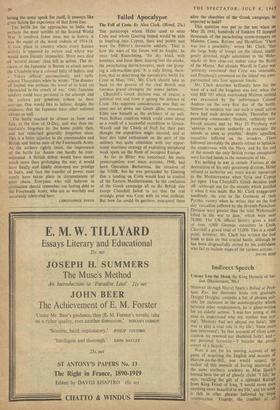The Battle of India
Tnis admirable description of the fighting on the North-Eastern Frontier in the war against Japan concentrates on the battle for Imphal in the spring and summer of 1944. The authors never stray from their subject, so that the reader iS told only just enough to go on with about the fgeneral scene and events next door: the Arakan campaign to the south, the Chindit expedition to the east, the slow advance of the Chinese- ,"American forces from the north-east. Given the intention, this close preoccupation with Imphal 41011C is fully justified, though the authors seem to carry principle too far in telling so little about the battle for Kohima, north of Imphal. This was part of the same Japanese attempt to break our Assam defences, and their defeat here was an important and integral part of the victory at Imphal.
The authors' purpose is description in detail of how it was; they make no claim to analysis Or criticism. They are openly partial. They give telling portraits, agreeable and otherwise, of Japanese leaders, while they treat British leaders With respect and affection and never credit them With mistakes. Their uncritical approach is some- times carried to excess. It comes out fairly clearly that the scattered disposition of IV Corps in klarch was a grave error, being a hangover from a British offensive plan made before the Japanese attack seemed likely. The dauntless fighting with which the divisions withdrew to concentration, after the attack, so damaged the Japanese that it may be that the Corps com- mander was not only saved from his misjudg- ment, but obtained advantages. The narrative would nevertheless command even more con- fidence if the case for and against the Corps commander had been put candidly; as it is, most readers new to these events—the majority—will re bewildered by an evasion of criticism. This extreme partiality may sound like a s i!rious fault, but in fact it is minor. The book Written from within the army and its object is to give the army's feeling. In this it succeeds arvellously. By recourse to every kind of con- ternporary document and eye-witness story, by
letting the army speak for itself, it conveys like great fiction the experience of that front-line.
The battle for the approaches to India was perhaps the most terrible of the Second World War. It involved fewer men, but in horror it was the equal of the worst ordeals of 1914-18. It took place in country where every human activity is opposed by nature and where war would seem literally impossible. More men died of 'natural causes' than fell in action. The de- cision of the Japanese in Burma to attack across the Chindwin was a colossal folly of hubris, and a Tokyo official unconsciously and aptly echoed Thucydides when he wrote: 'The disaster of Imphal was perhaps the worst of its kind yet chronicled in the annals of war.' Only Japanese soldiers could have persisted in the attempt, and the authors pay generous tribute to their courage. One would like to believe, despite the evidence, that the Japanese have other national virtues as well.
The battle reached its climax in June and July, at the time of D-Day, and was thus im- mediately forgotten by the home public then, and has remained generally forgotten since. This is a bitter injustice to the commanders and British and Indian men of the Fourteenth Army. As the authors rightly insist, the importance of the battle for Assam can hardly be over- estimated. A British defeat would have meant much more than prolonging the war; it would have finally and fatally destroyed our prestige in India, and then the transfer of power must surely have taken place in circumstances of utter chaos. Everyone who still believes in civilisation should remember our lasting debt to the Fourteenth Army, who are so worthily and accurately celebrated here.
CHRISTOPHER SYKES











































 Previous page
Previous page